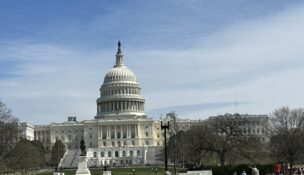US justices grapple with proximate cause in child porn case
By: KIMBERLY ATKINS, BridgeTower Media Newswires//January 24, 2014//
US justices grapple with proximate cause in child porn case
By: KIMBERLY ATKINS, BridgeTower Media Newswires//January 24, 2014//
The justices of the U.S. Supreme Court are struggling to determine how mandatory statutory damages to victims of child pornography should be allocated among those convicted of possessing and viewing the material, and what proof is required to establish liability.
The central issue in Paroline v. U.S., No. 12-8561, is whether the Sexual Exploitation of Children Act, which provides mandatory restitution to victims of child pornography for losses suffered from their exploitation, requires proof that each defendant’s possession or distribution of pornographic images of children proximately caused the amount of losses they are ordered to pay.
At oral arguments Wednesday, the justices were faced with three choices: require each defendant to be jointly liable for the full amount, require proof of proximate causation of a specific injury to be liable for any amount, or find some sort of compromise position under the statute to allow for partial liability.
Trying to find the answer in the statutory language proved difficult.
“There is a problem in child pornography cases,” Justice Stephen Breyer said. “Congress clearly wants restitution. Makes sense to me. But if a thousand people look at [the pornography], and the government doesn’t find a thousand — it only finds two or three — should they pay the whole thing?”
Defining causation
The statute, 18 U.S.C. §2259(b)(1), defines “full amount of the victim’s losses” as “any costs incurred by the victim for —
(A) medical services relating to physical, psychiatric, or psychological care;
(B) physical and occupational therapy or rehabilitation;
(C) necessary transportation, temporary housing, and child care expenses;
(D) lost income;
(E) attorneys’ fees, as well as other costs incurred; and
(F) any other losses suffered by the victim as a proximate result of the offense.”
Interpreting just what the proximate cause requirement entails has fractured the circuits.
In this case, Doyle Paroline pleaded guilty to possession of 150-300 images of child pornography, including two images of a girl identified in court as Amy Unknown which he downloaded from the Internet. Now an adult, she was 9 years old at the time the images were taken, but they continue to be distributed via the web.
Paroline was sentenced to two years in prison.
Amy sought restitution from Paroline under the statute for more than of $3.3 million, the amount calculated to represent her injury. But the district court ruled that neither Amy nor prosecutors provided proof that the full amount mount of the injury was proximately caused by Paroline and denied restitution.
The 5th U.S. Circuit Court of Appeals reversed, holding that the proximate cause requirement applied only to the “catchall” provision of § 2259(b)(3)(F). Otherwise, the court held, the defendant must provide restitution for all losses suffered by the victim.
That view is at odds with the position taken by other courts, including the 1st, 2nd, 4th, 6th, 9th, 11th and D.C. Circuits, which have all imposed some kind of causation requirement.
The Supreme Court granted Paroline’s petition for certiorari to resolve the split.
Nexus sought
Stanley Schneider of the Houston firm Schneider & McKinney argued on behalf of Paroline that some sort of nexus must be present between the defendant’s actions and the harm suffered by the victim, such as knowledge on the victim’s part that the individual viewed the images.
Justice Antonin Scalia expressed doubt at that interpretation.
“She has to know each individual who has been viewing her rape on these pornographic images [or] she can’t be covered?” he asked. “The other side says she ought to be able to recover everything from him. You say she ought to be able to recover nothing. What about something in between?”
Paul Cassell, a professor at S.J. Quinney College of Law at the University of Utah, represented Amy and other victims of pornography. He urged the justices to adopt a victim-focused view for the restitution statute, requiring full compensation and working out the allocation among perpetrators later.
“Each person who contributed to the loss [is] on the hook for the damages in their entirety,” Cassell said.
“Sock him for all of her psychiatric costs and everything else because he had two pictures of her?” Scalia asked. “Congress couldn’t have intended that.”
“The text of the statute tells us,” how much the defendant should pay, Cassell said. “It is the full amount.”
“Why?” Breyer asked. “The person didn’t cause the full amount. [Does] Congress want to have people pay for injury they didn’t cause?”
Justice Samuel A. Alito Jr. asked what happens when full recovery has already been obtained from one defendant before others are convicted.
“So … the first person convicted is the one assessed the restitution of $3 million, right?” he said. And everyone else pays nothing “because the first person paid everything?”
“That is exactly what Congress wanted,” Cassell replied.
Deputy U.S Solicitor General Michael Dreeben offered a middle ground approach: aggregate causation, in which the actions of the entire group of offenders would be considered the cause of the victim’s injuries and experts could establish the extent of each defendant’s contribution.
“There is a solution that tort law has developed for providing some restitution for Amy, not the entire restitution that would be owed on account of her entire loss,” he said.
But Scalia doubted if that was a viable solution to a statutory problem.
“We’re dealing here with a question of statutory interpretation,” he said. “So the question is not what does modern tort law allow, but the question is what reasonably could Congress have meant by this statute?”
A decision is expected later this year. Follow @dcdicta
Legal News
- Former Wisconsin police officer charged with 5 bestiality felony counts
- Judge reject’s Trump’s bid for a new trial in $83.3 million E. Jean Carroll defamation case
- The Latest: Supreme Court arguments conclude in Trump immunity case
- Net neutrality restored as FCC votes to regulate internet providers
- Wisconsin Attorney General asks Congress to expand reproductive health services
- Attorney General Kaul releases update at three-year anniversary of clergy and faith leader abuse initiative
- State Bar leaders remain deeply divided over special purpose trust
- Former Wisconsin college chancellor fired over porn career is fighting to keep his faculty post
- Pecker says he pledged to be Trump campaign’s ‘eyes and ears’ during 2016 race
- A conservative quest to limit diversity programs gains momentum in states
- Wisconsin prison inmate pleads not guilty to killing cellmate
- Waukesha man sentenced to 30 years for Sex Trafficking
WLJ People
- Power 30 Personal Injury Attorneys – Russell Nicolet
- Power 30 Personal Injury Attorneys – Benjamin Nicolet
- Power 30 Personal Injury Attorneys – Dustin T. Woehl
- Power 30 Personal Injury Attorneys – Katherine Metzger
- Power 30 Personal Injury Attorneys – Joseph Ryan
- Power 30 Personal Injury Attorneys – James M. Ryan
- Power 30 Personal Injury Attorneys – Dana Wachs
- Power 30 Personal Injury Attorneys – Mark L. Thomsen
- Power 30 Personal Injury Attorneys – Matthew Lein
- Power 30 Personal Injury Attorneys – Jeffrey A. Pitman
- Power 30 Personal Injury Attorneys – William Pemberton
- Power 30 Personal Injury Attorneys – Howard S. Sicula











